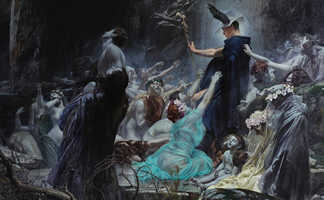Demeter (“Dimitra” in Greek, with the accent on the first, long “i”) is the last of the original six gods born to Cronus and Gaia (Zeus, Poseidon, Hades, Hera, Hestia, Demeter), which were, with the exception of Zeus, gruesomely swallowed, and then upchucked by Cronus after Zeus’s sneaky administration of an emetic. Demeter was arguably the most important deity to the literal everyday survival of ancient Greeks by virtue of her intimate connection to agriculture.
She is the chief life cycle goddess of the Greek pantheon. She oversaw the sowing, growing, and reaping of grain crops, olives, fruits, vegetables, and other vegetation so vital for life on earth.
Because of Demeter’s central role in the lives of Greeks, she figures in many, many stories in the oeuvre of Greek mythology. Her Roman counterpart was Ceres. You can see that the name Ceres gave us the word “cereal.” In similar fashion, “dimetriaka” is the Greek word for cereal.
The Seasons
Her central myth has been told twice already in this blog (see the post on Hades for a fuller version), but suffice it to say that the Greeks created this myth to explain the cycle of the seasons. It told of the abduction of Demeter’s daughter, Persephone, by Hades, god of the underworld, which caused deep depression and mourning in the heart of Demeter, resulting in cold weather and its accompanying withering and dying off of earth’s vegetation. This became the origin story of winter. When Hades granted that Demeter could have her daughter back from the underworld for six months every year, she rejoiced at their reunion, temperatures rose, rain fell, and crops flourished, which is the explanation for summer.
The place Persephone was reunited with Demeter, Eleusina, on the coast about twenty kilometers west of Athens, became the site of a complex of temples dedicated to Demeter, Persephone and other deities, and became home of the most important of the secret religious rites of ancient Greece whose theme was Persephone’s journey back to the land of the living.
Eleusinian Mysteries
The details of the fascinating Eleusinian Mysteries festival, of which participants were sworn to secrecy under pain of death, were so successfully hidden that they are still largely unknown. Celebrants fasted for three days and, after a night of ritualized dancing, drank a substance known as kykeon, which is suspected of having hallucinogenic properties due to the inclusion of ergot, which can be a psychoactive ingredient. Kalliope Papaneli, chief archeologist at Eleusina, who has been working at the Eleusina site for more than three decades, believes that kykeon was nothing more than a barley-based somewhat alcoholic mash whose effects were amplified because of the previous days of fasting.
The high point of the Eleusinian Mysteries was a re-enactment of the return of Persephone to the land of the living from Hades from a local well with steps cut into it to symbolize the entrance to the underworld, probably by a priestess. This was a torch lit ceremony which took place only at night, which added an enhanced dramatic effect.
Thesmophoros
In addition to life cycle religious events, Demeter also presided over a system of traditional moral codes known collectively as Sacred Law which also had the cycle of life and death as their overarching theme. In this aspect she was called the “Thesmophoros,” “the giver of customs.”
She and Persephone were the main figures in a fertility festival known as the Thesmophora. This was a very common secret celebration open only to adult women which took place at seed-sowing time in the late autumn. It commemorated the life-giving powers of the earth, and, by extension, of women. The comedic playwright Aristophanes wrote a play, the Thesmophoriazusae, which poked fun at such human foibles as the self-importance of some Greek tragic playwrights, the greed and vulgarity of the common citizen of Athens, and the subversive role of women in the patriarchic Athenian culture. The play is sprinkled liberally with broad, physical comedic elements and sexual innuendo.
The Agricultural Revolution
Greeks were a famously seafaring people, but, as all other cultures BC, they were primarily an agricultural people. Until about 800 BC, it took nine Greeks to feed ten (by contrast, in the USA, one farmer feeds one hundred). This means that most people spent most of their time in subsistence farming. Sometimes in the 800’s BC, Greeks discovered grafting. They learned to attach cuttings of very productive vines and fruits onto older, sturdier, but less productive stock.
These older trees had deep roots, but little fruit. The new grafts had lots of fruit, but little root. The combination of the two via grafting allowed for much greater fruit production in a smaller area. At the same time, crop productivity was additionally increased by the use of manure and other fertilization techniques. These techniques led to what is known as the “Mediterranean Triad:” grapes, olive trees, and grain crops.
Barley and wheat began to be harvested in May. This provided a stable base for the diet. Bread and soups can be made from grains. Then grapes, harvested in the early autumn, provided a non-perishable, nourishing drink in the form of wine, and additional long-term in the form of raisins. Add olives and their oil to the mix, and you’re able to survive comfortably the year round.
Because for the first time in history crops were diverse, and, additionally, harvested at different times of the year (grains in early summer, grapes in later summer, olives in the autumn), two problems were addressed: one, the diversity of crops raised the odds of survivability (if hail wiped out your grain crop, you still had grapes and olives, for example), and, two, staggered harvest times made the labor of gathering harvests less demanding.
All of this meant that far fewer Greeks could feed a proportionately greater number of their fellow citizens. Out of these developments the ancient Greek culture arose, which emphasized property rights, which in turn led to the establishment of the middle class, and which, perhaps most importantly, allowed fewer farmers to feed more people. This freed Greeks to learn how to think, how to build, how to create art, how to pursue scientific activity, how to write plays and to think philosophically, how to study medicine, and how to create an effective, egalitarian military force with unique tactics.
Thus arose, eventually, the glory that was ancient Greece. You can see how, in the midst of all of this, critical the worship of Demeter was to such an agrarian culture. Triptolemos was the demigod who is most closely associated with the teaching of agriculture to the ancient Greeks. He was the son of the king of Eleusina, who met Demeter while she was searching for her daughter Persephone. After Persephone’s return from the underworld, Demeter taught Triptolemos the agricultural arts, which he then disseminated throughout the Greek-speaking world.
Demeter is often worshipped in tandem with Dionysus, god of wine. He’ll be the subject of the next blog post.




















